Design and Experimental Evaluation of an Odor Sensing Method for a Pocket-Sized Quadcopter
Abstract
:1. Introduction
2. Problem Statement
- ◯: The quadcopter can pass through any door, and it can safely fly inside a building.
- △: The quadcopter cannot pass through some doors, and sometimes, it is difficult for it to fly inside a building.
- ×: The quadcopter cannot pass through any door and fly safely inside a building.
- Design a lightweight and compact system with a weight of 40 g or less to detect the presence/absence of a chemical (ethanol).
- Select and implement an algorithm that can realize three-dimensional CPT in real time.
- Design and verify an intake system that does not require additional actuators. Here, the intake system implies how to intake air into the alcohol sensor.
3. Construction of a Pocket-Sized Quadcopter System
3.1. System Overview
3.2. Control Board
3.3. System Identification of an Alcohol Sensor
3.4. Search Algorithm
4. Determination of Sensor Arrangement
5. Directivity Experiment of Odor Detection
5.1. Experiment 1: Experimental Design
5.2. Experiment 1: Result
5.3. Experiment 2: Experimental Design
5.4. Experiment 2: Results
6. Three-Dimensional CPT Experiment
6.1. Experimental Design
6.2. Results
7. Conclusions
Supplementary Materials
Author Contributions
Funding
Acknowledgments
Conflicts of Interest
Abbreviations
| CPT | Chemical plume tracing |
| ARX | Auto-regressive with an exogenous input |
| PIV | Particle image velocimetry |
Appendix A
References
- Falanga, D.; Mueggler, E.; Faessler, M.; Scaramuzza, D. Aggressive quadrotor flight through narrow gaps with onboard sensing and computing using active vision. In Proceedings of the 2017 IEEE International Conference on Robotics and Automation (ICRA), Singapore, 29 May–3 June 2017; pp. 5774–5781. [Google Scholar]
- Mellinger, D.; Michael, N.; Kumar, V. Trajectory generation and control for precise aggressive maneuvers with quadrotors. Int. J. Robot. Res. 2012, 31, 664–674. [Google Scholar] [CrossRef]
- Cutler, M.; How, J.P. Analysis and control of a variable-pitch quadrotor for agile flight. J. Dyn. Syst. Meas. Control 2015, 137, 101002. [Google Scholar] [CrossRef]
- Müller, M.; Lupashin, S.; D’Andrea, R. Quadrocopter ball juggling. In Proceedings of the 2011 IEEE/RSJ International Conference Intelligent Robots and Systems (IROS), San Francisco, CA, USA, 25–30 September 2011; pp. 5113–5120. [Google Scholar]
- Cowen, E.A.; Ward, K.B. Chemical plume tracing. Environ. Fluid Mech. 2002, 2, 1–7. [Google Scholar] [CrossRef]
- Li, W.; Tian, Y. Chemical Plume Tracing and Mapping via Swarm Robots. In Handbook of Research on Design, Control, and Modeling of Swarm Robotics; IGI Publishing: Hershey, PA, USA, 2016; pp. 421–455. [Google Scholar] [Green Version]
- Keller, A.; Zhuang, H.; Chi, Q.; Vosshall, L.B.; Matsunami, H. Genetic variation in a human odorant receptor alters odour perception. Nature 2007, 449, 468. [Google Scholar] [CrossRef] [PubMed]
- Ishihara, S.; Azzarelli, J.M.; Krikorian, M.; Swager, T.M. Ultratrace detection of toxic chemicals: Triggered disassembly of supramolecular nanotube wrappers. J. Am. Chem. Soc. 2016, 138, 8221–8227. [Google Scholar] [CrossRef] [PubMed]
- Willis, M.A. Chemical plume tracking behavior in animals and mobile robots. Navigation 2008, 55, 127–135. [Google Scholar] [CrossRef]
- Murlis, J.; Jones, C.D. Fine-scale structure of odour plumes in relation to insect orientation to distant pheromone and other attractant sources. Physiol. Entomol. 1981, 6, 71–86. [Google Scholar] [CrossRef]
- Celani, A.; Villermaux, E.; Vergassola, M. Odor landscapes in turbulent environments. Phys. Rev. X 2014, 4, 041015. [Google Scholar] [CrossRef]
- Monroy, J.; Hernandez-Bennetts, V.; Fan, H.; Lilienthal, A.; Gonzalez-Jimenez, J. GADEN: A 3D gas dispersion simulator for mobile robot olfaction in realistic environments. Sensors 2017, 17, 1479. [Google Scholar] [CrossRef] [PubMed]
- Ferri, G.; Jakuba, M.V.; Mondini, A.; Mattoli, V.; Mazzolai, B.; Yoerger, D.R.; Dario, P. Mapping multiple gas/odor sources in an uncontrolled indoor environment using a Bayesian occupancy grid mapping based method. Robot. Auton. Syst. 2011, 59, 988–1000. [Google Scholar] [CrossRef] [Green Version]
- Vergassola, M.; Villermaux, E.; Shraiman, B.I. ‘Infotaxis’ as a strategy for searching without gradients. Nature 2007, 445, 406–409. [Google Scholar] [CrossRef] [PubMed]
- Farrell, J.A.; Pang, S.; Li, W. Chemical plume tracing via an autonomous underwater vehicle. IEEE J. Ocean. Eng. 2005, 30, 428–442. [Google Scholar] [CrossRef]
- Yuan, J.; Oswald, D.; Li, W. Autonomous tracking of chemical plumes developed in both diffusive and turbulent airflow environments using Petri nets. Expert Syst. Appl. 2015, 42, 527–538. [Google Scholar] [CrossRef]
- Li, W.; Farrell, J.A.; Pang, S.; Arrieta, R.M. Moth-inspired chemical plume tracing on an autonomous underwater vehicle. IEEE Trans. Robot. 2006, 22, 292–307. [Google Scholar] [CrossRef] [Green Version]
- Ishida, H.; Wada, Y.; Matsukura, H. Chemical sensing in robotic applications: A review. IEEE Sens. J. 2012, 12, 3163–3173. [Google Scholar] [CrossRef]
- Neumann, P.P.; Hernandez Bennetts, V.; Lilienthal, A.J.; Bartholmai, M.; Schiller, J.H. Gas source localization with a micro-drone using bio-inspired and particle filter-based algorithms. Adv. Robot. 2013, 27, 725–738. [Google Scholar] [CrossRef]
- Neumann, P.P.; Asadi, S.; Lilienthal, A.J.; Bartholmai, M.; Schiller, J.H. Autonomous gas-sensitive microdrone: Wind vector estimation and gas distribution mapping. IEEE Robot. Autom. Mag. 2012, 19, 50–61. [Google Scholar] [CrossRef]
- Eu, K.S.; Yap, K.M. Chemical plume tracing: A three-dimensional technique for quadrotors by considering the altitude control of the robot in the casting stage. Int. J. Adv. Robot. Syst. 2018, 15, 1729881418755877. [Google Scholar] [CrossRef]
- Luo, B.; Meng, Q.H.; Wang, J.Y.; Zeng, M. A Flying Odor Compass to Autonomously Locate the Gas Source. IEEE Trans. Instrum. Meas. 2018, 67, 137–149. [Google Scholar] [CrossRef]
- Roberts, J. Enabling Collective Operation of Indoor Flying Robots; École polytechnique fédérale de Lausanne (EPFL): Lausanne, Switzerland, 2011. [Google Scholar]
- Eu, K.S.; Yap, K.M.; Tee, T.H. An airflow analysis study of quadrotor based flying sniffer robot. Appl. Mech. Mater. 2014, 627, 246–250. [Google Scholar] [CrossRef]
- Brady, J.; Gibson, G.; Packer, M.J. Odour movement, wind direction, and the problem of host-finding by tsetse flies. Physiol. Entomol. 1989, 14, 369–380. [Google Scholar] [CrossRef]
- Luo, B.; Meng, Q.H.; Wang, J.Y.; Ma, S.G. Simulate the aerodynamic olfactory effects of gas-sensitive UAVs: A numerical model and its parallel implementation. Adv. Eng. Softw. 2016, 102, 123–133. [Google Scholar] [CrossRef]
- Mafra-Neto, A.; Cardé, R.T. Fine-scale structure of pheromone plumes modulates upwind orientation of flying moths. Nature 1994, 369, 142–144. [Google Scholar] [CrossRef]
- Vickers, N.J. Mechanisms of animal navigation in odor plumes. Biol. Bull. 2000, 198, 203–212. [Google Scholar] [CrossRef] [PubMed]
- Bau, J.; Cardé, R.T. Modeling optimal strategies for finding a resource-linked, windborne odor plume: Theories, robotics, and biomimetic lessons from flying insects. Integr. Comp. Biol. 2015, 55, 461–477. [Google Scholar] [CrossRef] [PubMed]
- Willis, M.A.; Cardé, R.T. Pheromone-modulated optomotor response in male gypsy moths, Lymantria dispar L.: Upwind flight in a pheromone plume in different wind velocities. J. Comp. Physiol. A Neuroethol. Sens. Neural Behav. Physiol. 1990, 167, 699–706. [Google Scholar] [CrossRef]
- Lockey, J.K.; Willis, M.A. One antenna, two antennae, big antennae, small: Total antennae length, not bilateral symmetry, predicts odor tracking performance in the American cockroach, Periplaneta americana L. J. Exp. Biol. 2015, 218, 2156–2165. [Google Scholar] [CrossRef] [PubMed]
- Nishino, H.; Iwasaki, M.; Paoli, M.; Kamimura, I.; Yoritsune, A.; Mizunami, M. Spatial receptive fields for odor localization. Curr. Biol. 2018, 28, 600–608. [Google Scholar] [CrossRef] [PubMed]
- Kanzaki, R.; Sugi, N.; Shibuya, T. Self-generated zigzag turning of Bombyx mori males during pheromone-mediated upwind walking (Physology). Zool. Sci. 1992, 9, 515–527. [Google Scholar]
- Takasaki, T.; Namiki, S.; Kanzaki, R. Use of bilateral information to determine the walking direction during orientation to a pheromone source in the silkmoth Bombyx mori. J. Comp. Physiol. A 2012, 198, 295–307. [Google Scholar] [CrossRef] [PubMed]
- Shigaki, S.; Sakurai, T.; Ando, N.; Kurabayashi, D.; Kanzaki, R. Time-Varying Moth-Inspired Algorithm for Chemical Plume Tracing in Turbulent Environment. IEEE Robot. Autom. Lett. 2018, 3, 76–83. [Google Scholar] [CrossRef]
- Join GitHub Today. Available online: https://github.com/voodootikigod/node-rolling-spider (accessed on 15 November 2016).
- MiCS Application Note 4 Using MiCS Sensors for Alcohol Detection. Available online: https://cdn-shop.adafruit.com/product-files/3199/AN4-Using-MiCS-Sensors-for-Alcohol-Detection.pdf (accessed on 15 November 2016).
- Dorsey, K.L.; Pisano, A.P. Stability and Control of a Metal Oxide Gas Sensor in Simulated Wind. IEEE Sens. J. 2016, 16, 699–705. [Google Scholar] [CrossRef]
- Ishida, H.; Kaneko, S.; Tsujita, W.; Yoshino, A.; Moriizumi, T. Improvement of measurement accuracy in environmental monitoring system based on semiconductor gas sensor. IEEJ Trans. Sens. Micromach. 2005, 125, 245–252. [Google Scholar] [CrossRef]
- Monroy, J.G.; González-Jiménez, J.; Blanco, J.L. Overcoming the slow recovery of mox gas sensors through a system modeling approach. Sensors 2012, 12, 13664–13680. [Google Scholar] [CrossRef] [PubMed]
- Rachad, S.; Nsiri, B.; Bensassi, B. System Identification of Inventory System Using ARX and ARMAX Models. Int. J. Control Autom. 2015, 8, 283–294. [Google Scholar] [CrossRef]
- MathWorks. Available online: https://jp.mathworks.com/help/ident/ref/arx.html (accessed on 9 October 2018).
- Li, C.J.; Jeon, Y.C. Genetic algorithm in identifying non linear auto regressive with exogenous input models for non linear systems. In Proceedings of the 1993 American Control Conference, San Francisco, CA, USA, 2–4 June 1993; pp. 2305–2309. [Google Scholar]
- Obara, T. Bombyx mori Mationg Dance: An Essential in Locationg the Female. Appl. Entomol. Zool. 1979, 14, 130–132. [Google Scholar] [CrossRef]
- Adrian, R.J. Twenty years of particle image velocimetry. Exp. Fluids 2005, 39, 159–169. [Google Scholar] [CrossRef] [Green Version]
- Okamoto, K.; Nishio, S.; Saga, T.; Kobayashi, T. Standard images for particle-image velocimetry. Meas. Sci. Technol. 2000, 11, 685. [Google Scholar] [CrossRef]
- Huang, R.F.; Lin, S.Y.; Jan, S.Y.; Hsieh, R.H.; Chen, Y.K.; Chen, C.W.; Yeh, W.Y.; Chang, C.P.; Shih, T.S.; Chen, C.C. Aerodynamic characteristics and design guidelines of push-pull ventilation systems. Ann. Occup. Hyg. 2004, 49, 1–15. [Google Scholar] [PubMed]
- Ando, N.; Emoto, S.; Kanzaki, R. Odour-tracking capability of a silkmoth driving a mobile robot with turning bias and time delay. Bioinspir. Biomim. 2013, 8, 016008. [Google Scholar] [CrossRef] [PubMed]
- Bau, J.; Cardé, R.T. Simulation modeling to interpret the captures of moths in pheromone-baited traps used for surveillance of invasive species: The gypsy moth as a model case. J. Chem. Ecol. 2016, 42, 877–887. [Google Scholar] [CrossRef] [PubMed]
- Miller, J.R.; Adams, C.G.; Weston, P.A.; Schenker, J.H. Trapping of Small Organisms Moving Randomly: Principles and Applications to Pest Monitoring and Management; Springer: Berlin, Germany, 2015. [Google Scholar]
- Zarzhitsky, D.; Spears, D.F. Swarm approach to chemical source localization. In Proceedings of the IEEE International Conference Systems, Man and Cybernetics, Waikoloa, HI, USA, 10–12 October 2005; Volume 2, pp. 1435–1440. [Google Scholar]
- Huh, J.H.; Seo, K. An indoor location-based control system using bluetooth beacons for IoT systems. Sensors 2017, 17, 2917. [Google Scholar] [CrossRef] [PubMed]
- Amrita, L.P.; Kumaar, A.N. Bluetooth RSSI based collision avoidance in multirobot environment. In Proceedings of the 2016 International Conference Advances in Computing, Communications and Informatics (ICACCI), Jaipur, India, 21–24 September 2016; pp. 2168–2174. [Google Scholar]
- Loutfi, A.; Coradeschi, S.; Lilienthal, A.J.; Gonzalez, J. Gas distribution mapping of multiple odour sources using a mobile robot. Robotica 2009, 27, 311–319. [Google Scholar] [CrossRef]
- Monroy, J.G.; Blanco, J.L.; Gonzalez-Jimenez, J. Time-variant gas distribution mapping with obstacle information. Auton. Robot. 2016, 40, 1–16. [Google Scholar] [CrossRef]
- Garzón, M.; Valente, J.; Zapata, D.; Barrientos, A. An aerial-ground robotic system for navigation and obstacle mapping in large outdoor areas. Sensors 2013, 13, 1247–1267. [Google Scholar] [CrossRef] [PubMed]
- Novotnỳ, J.; Manoch, L. The Criterion of Choosing the Proper Seeding Particles. Eng. Mech. 2012, 201, 945–954. [Google Scholar]
- Chen, F.; Liu, H.; Yang, Z.; Hu, H. Tracking characteristics of tracer particles for PIV measurements in supersonic flows. Chin. J. Aeronaut. 2017, 30, 577–585. [Google Scholar] [CrossRef]



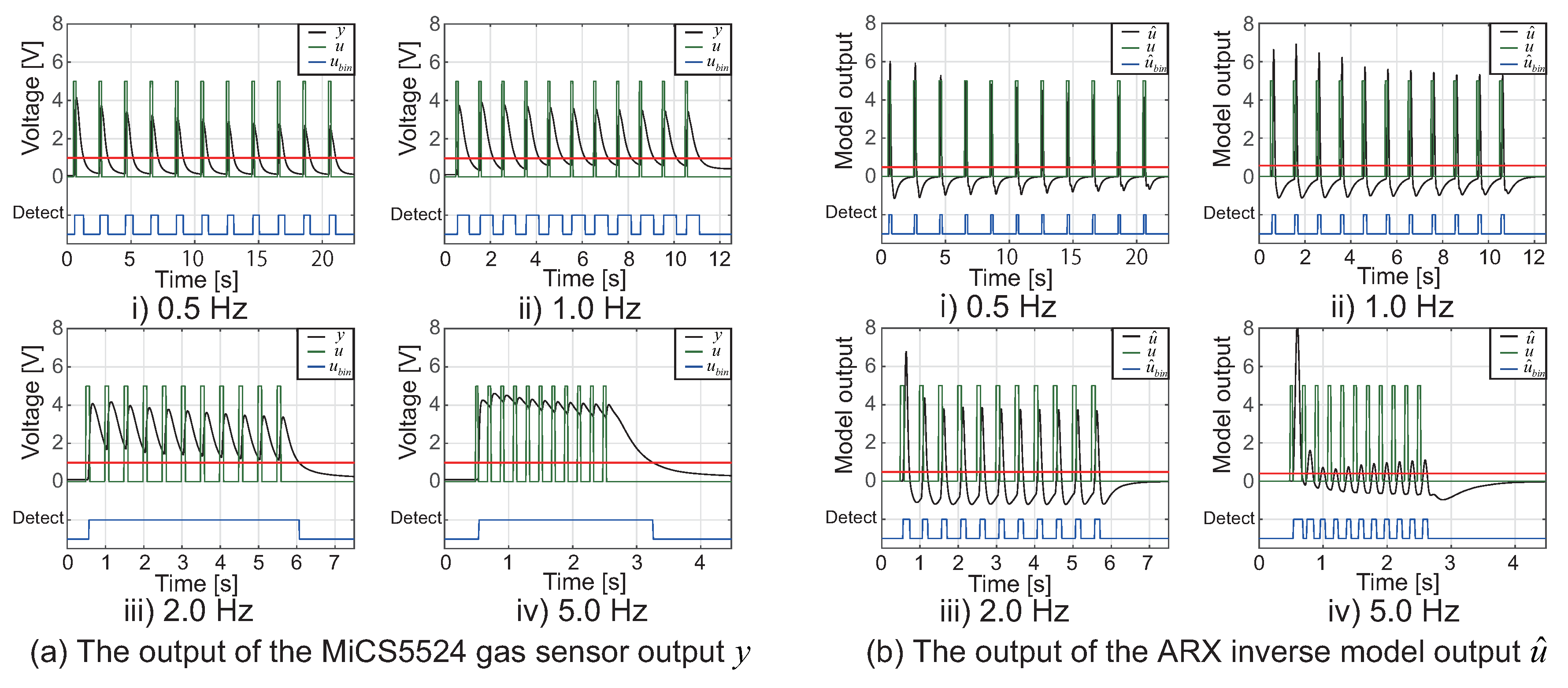
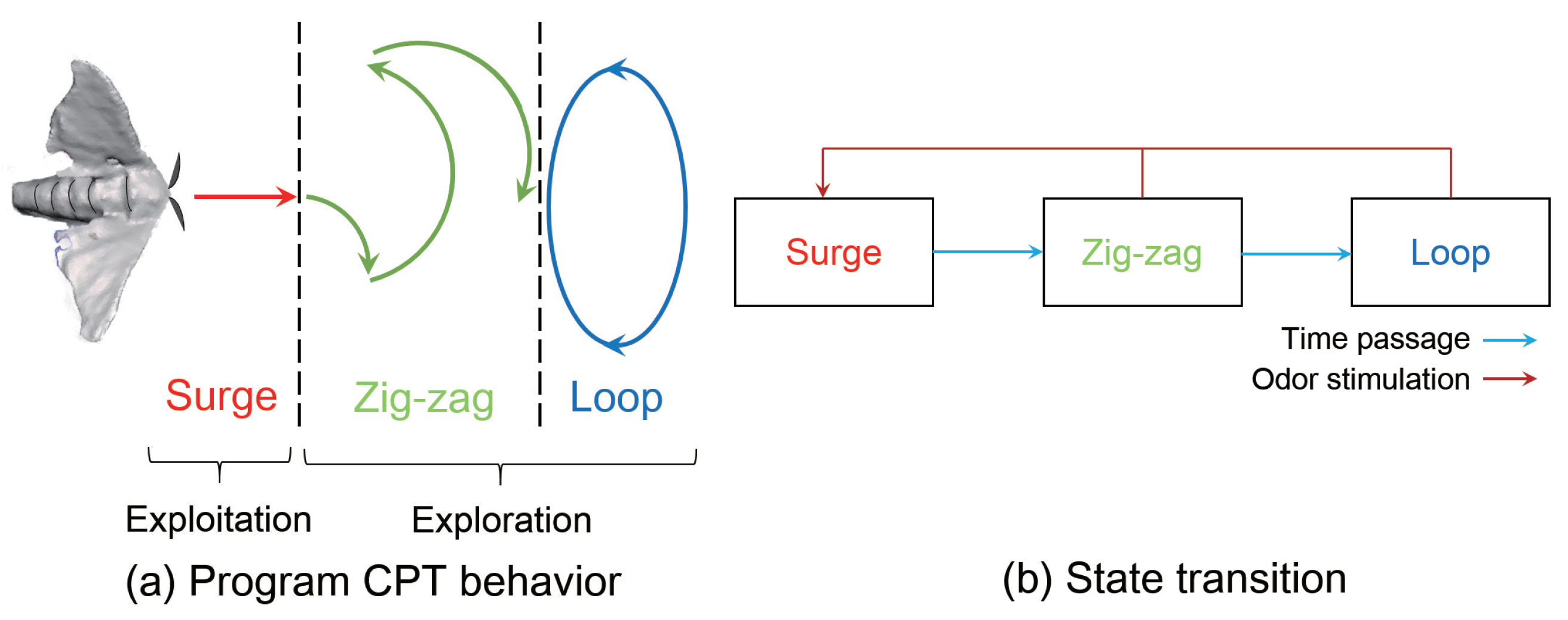




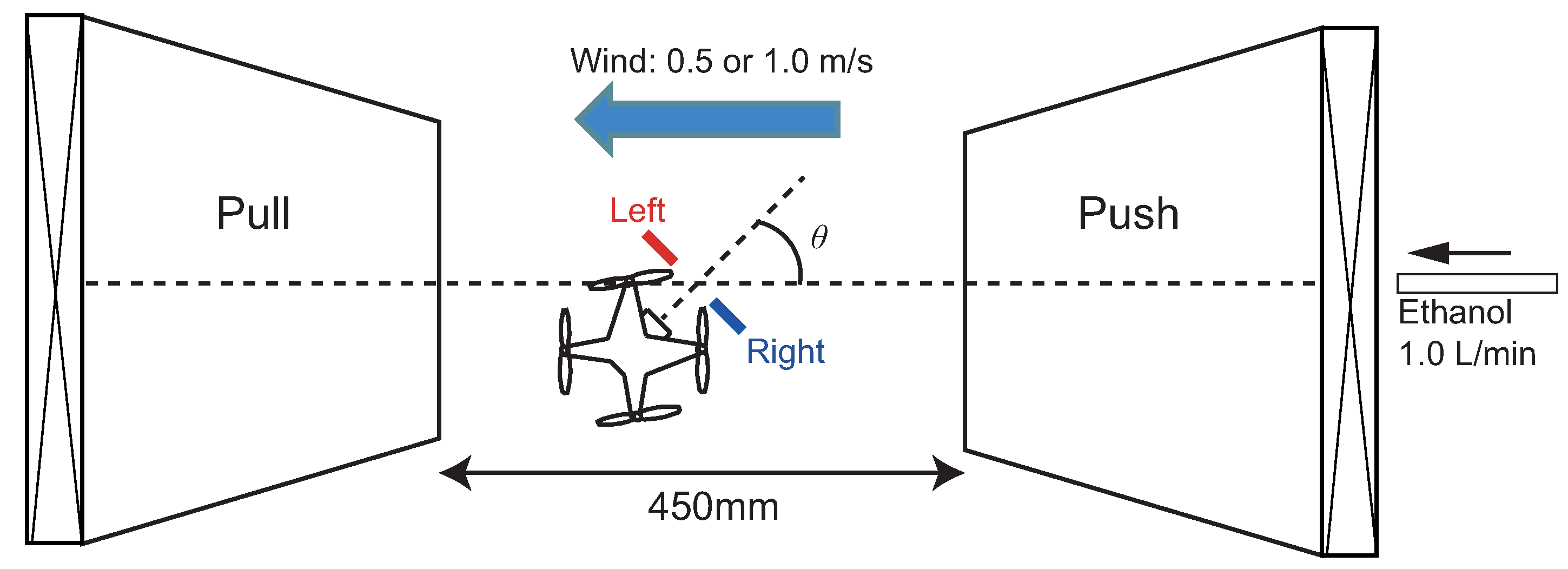
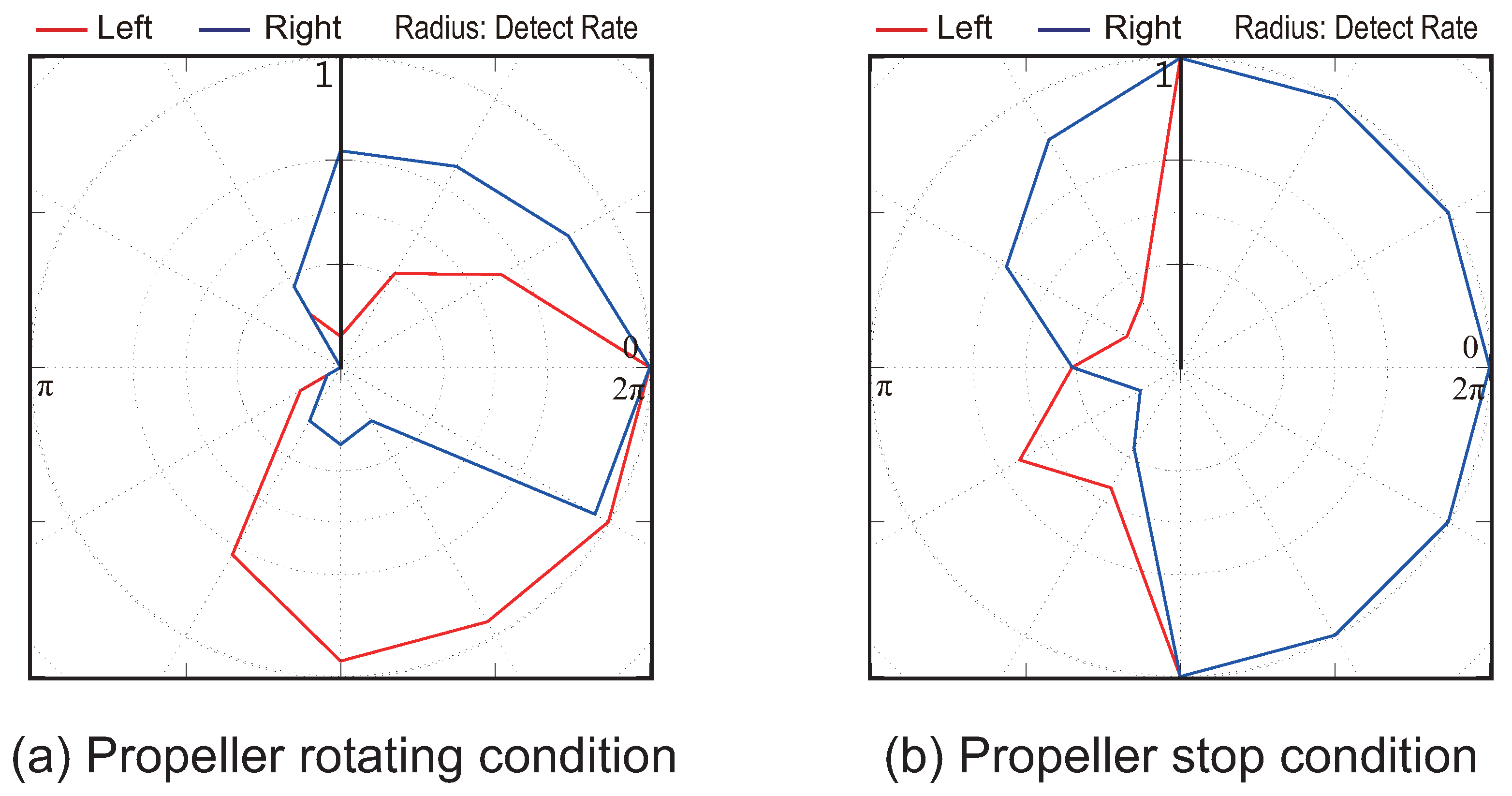
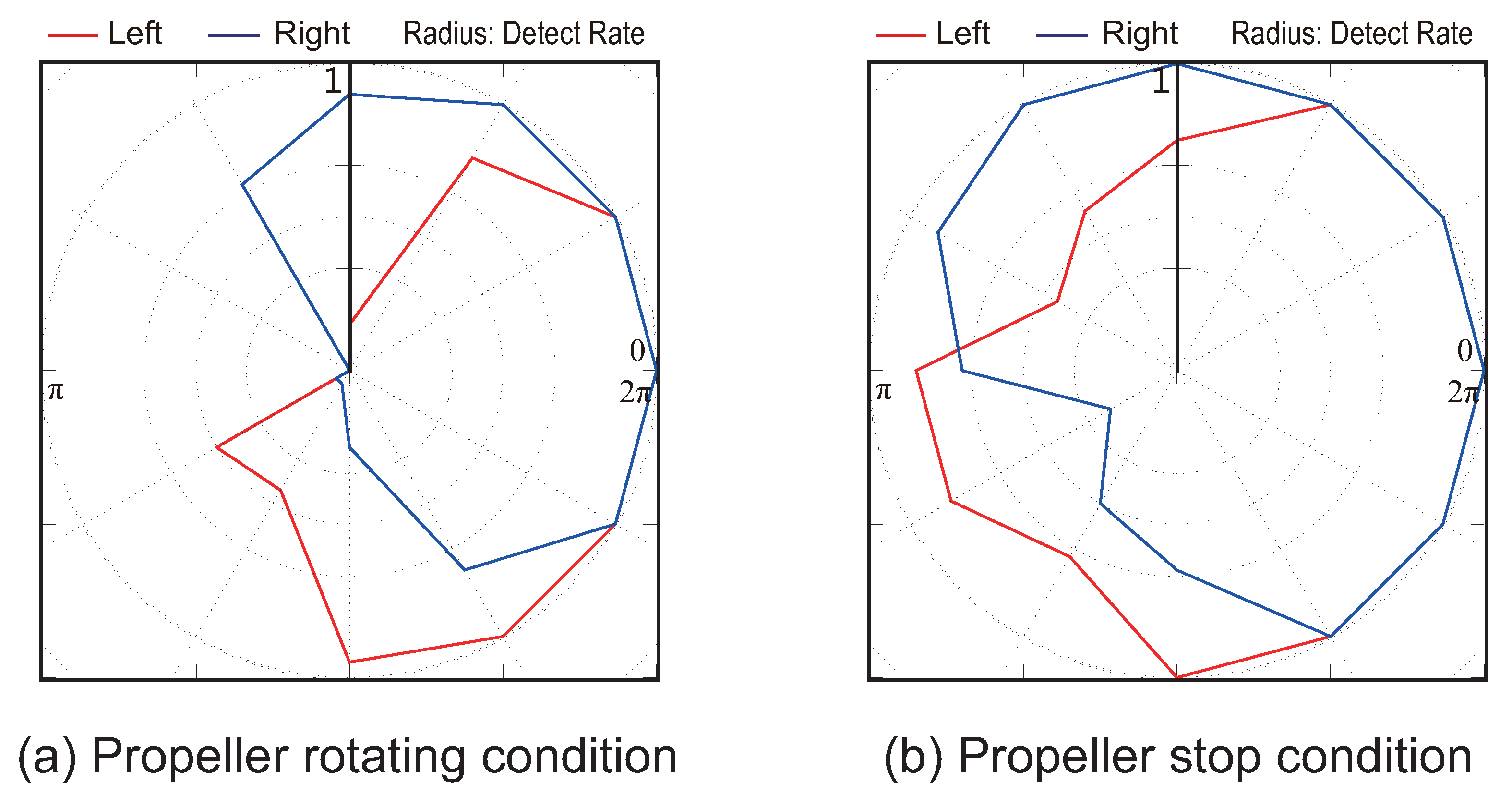
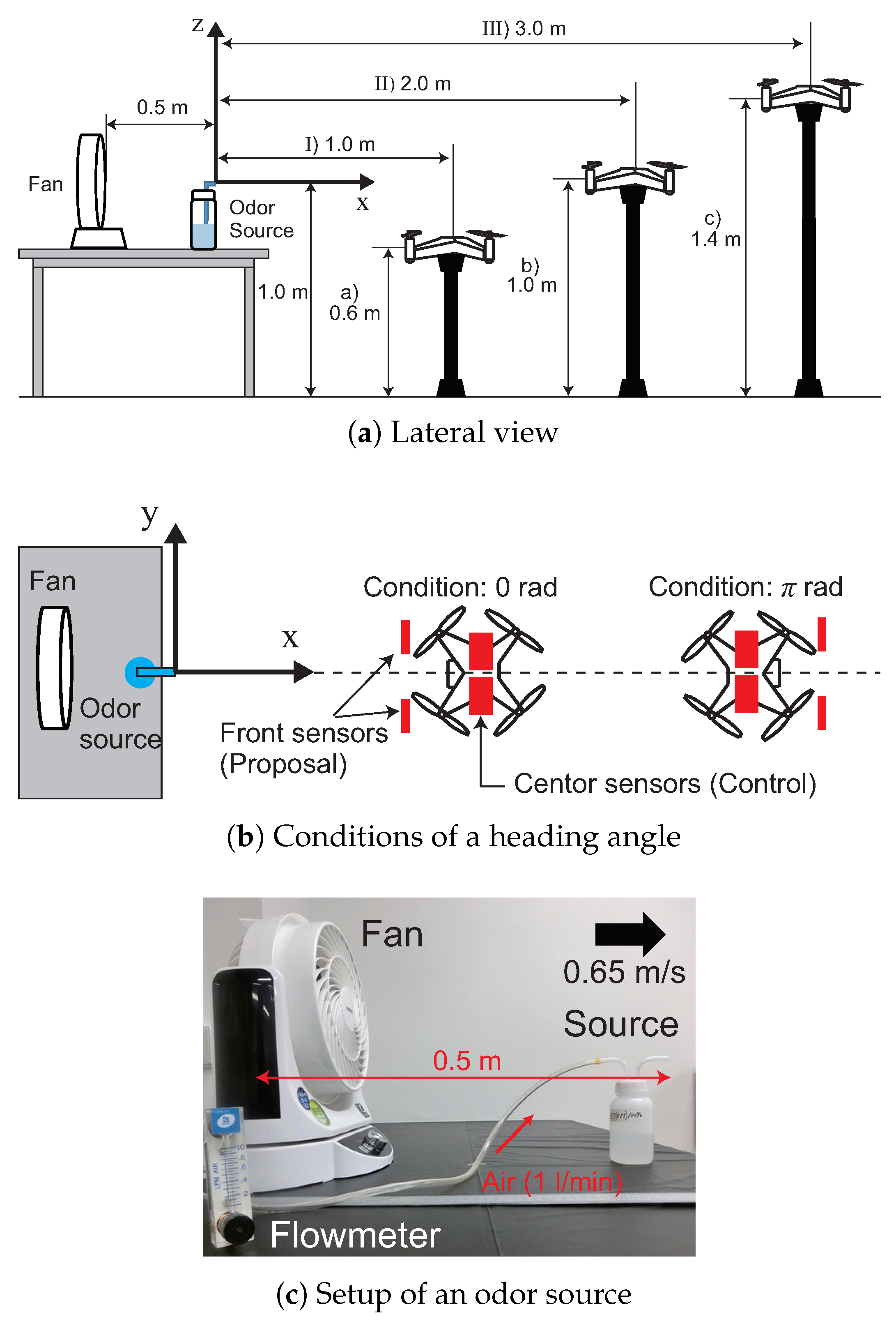



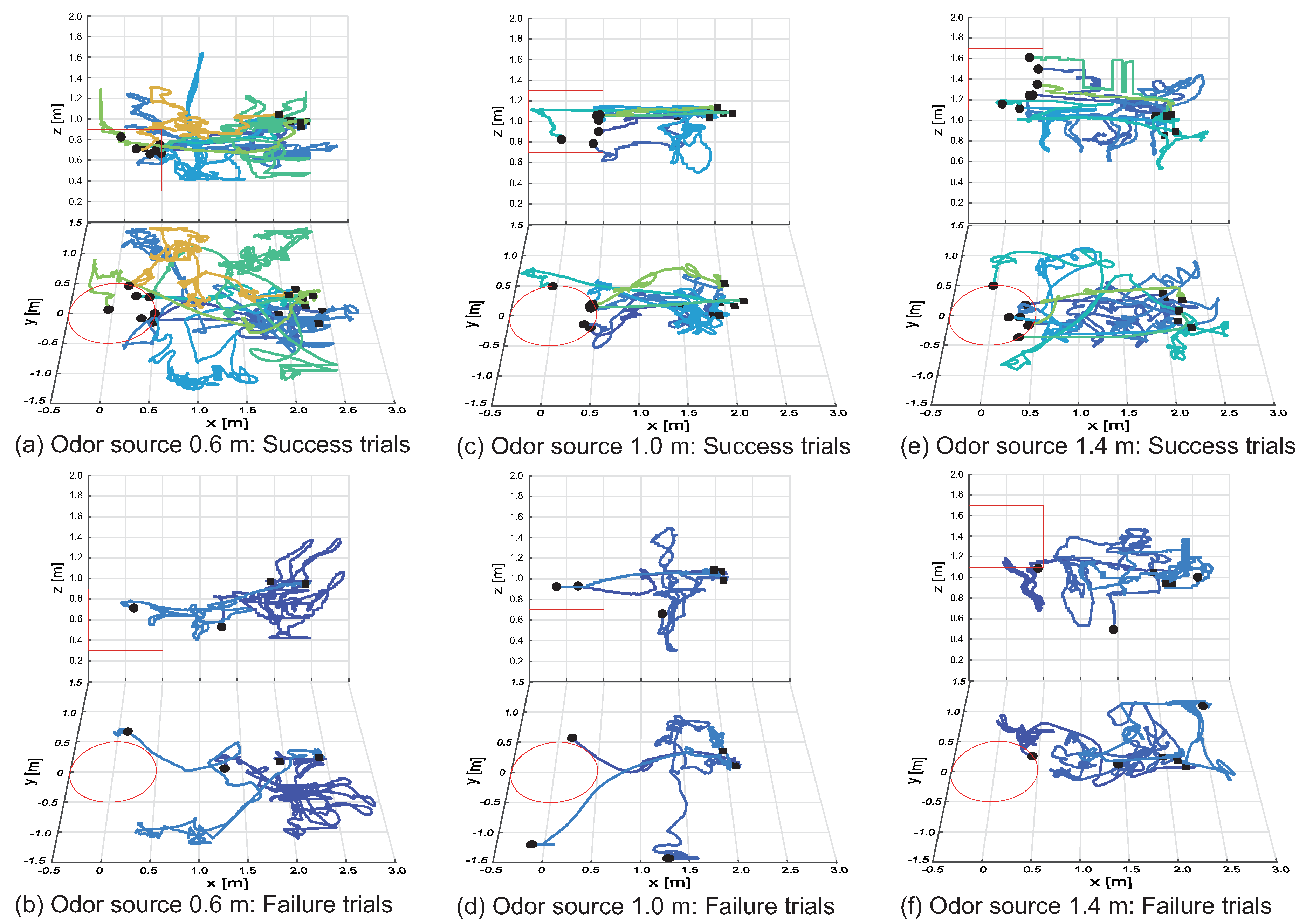
| Indoor | Classification | Frame Diameter (m) | Example |
|---|---|---|---|
| ◯ | Pocket size | ≤0.2 | Parrot Airborne |
| ◯ | Small size | ≤0.6 | Clearpath Hummingbird |
| △ | Middle size | ≤1.0 | Airrobot AR100-B |
| × | Large size | >1.0 | DJI Matrice 100 |
| −0.981 | 0.0165 | 0.283 | −0.271 |
| Source Height (m) | Search Success Rate (%) | Search Time (s) |
|---|---|---|
| 0.6 | 80 | 74.7 ± 44.5 |
| 1.0 | 80 | 29.5 ± 22.3 |
| 1.4 | 70 | 56.8 ± 31.8 |
© 2018 by the authors. Licensee MDPI, Basel, Switzerland. This article is an open access article distributed under the terms and conditions of the Creative Commons Attribution (CC BY) license (http://creativecommons.org/licenses/by/4.0/).
Share and Cite
Shigaki, S.; Fikri, M.R.; Kurabayashi, D. Design and Experimental Evaluation of an Odor Sensing Method for a Pocket-Sized Quadcopter. Sensors 2018, 18, 3720. https://doi.org/10.3390/s18113720
Shigaki S, Fikri MR, Kurabayashi D. Design and Experimental Evaluation of an Odor Sensing Method for a Pocket-Sized Quadcopter. Sensors. 2018; 18(11):3720. https://doi.org/10.3390/s18113720
Chicago/Turabian StyleShigaki, Shunsuke, Muhamad Rausyan Fikri, and Daisuke Kurabayashi. 2018. "Design and Experimental Evaluation of an Odor Sensing Method for a Pocket-Sized Quadcopter" Sensors 18, no. 11: 3720. https://doi.org/10.3390/s18113720





